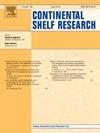Reproduction features of ocean quahog, Arctica islandica (Linnaeus, 1767), in the White Sea
IF 2.2
3区 地球科学
Q2 OCEANOGRAPHY
引用次数: 0
Abstract
The gametogenic cycle of ocean quahog, Arctica islandica, was investigated using specimens collected from a near-shore bed (10–15 m deep) in the Kandalaksha Bay of the White Sea during five summer seasons (1983, 1984, 2011, 2015, 2017). At present, the White Sea is the eastern distribution boundary of this mollusk. Local environmental conditions there differ considerably from those in other parts of its range, and many characteristics of the quahog populations in the White Sea are still poorly understood. In this study, we examined gonads from 384 ocean quahogs with shell length over 30 mm prepared with the use of standard histological techniques. The results showed that the reproductive cycle features of A. islandica in the White Sea were generally similar to those in other parts of its distribution. Clams in the spawning state were found mainly from the second half of July to October at a near-bottom water temperature of 9–15 °C. Both average (60–70 μm) and maximum (92–95 μm) size of mature oocytes of ocean quahogs from the White Sea were similar to those in North Atlantic populations. At the same time, we noted substantial interannual shifts in the spawning activity of A. islandica and showed that they reflected interannual changes in hydrological characteristics. However, it is unlikely that these shifts may affect the overall recruitment success of the population of this species.
白海大洋魁蚶(Arctica islandica (Linnaeus, 1767))的繁殖特征
利用五个夏季(1983、1984、2011、2015、2017)从白海康达拉沙湾近岸海床(10-15 米深)采集的标本,研究了大洋魁蚶的配子周期。目前,白海是这种软体动物的东部分布边界。当地的环境条件与其分布区的其他地区有很大不同,人们对白海魁蚶种群的许多特征仍知之甚少。在这项研究中,我们采用标准的组织学技术,对 384 个贝壳长度超过 30 毫米的大洋魁蚶的性腺进行了检查。结果表明,白海岛蛤的生殖周期特征与其分布的其他地区基本相似。产卵状态的蛤蜊主要出现在 7 月下半月至 10 月,近底水温为 9-15 °C。白海大洋魁蚶成熟卵母细胞的平均尺寸(60-70 μm)和最大尺寸(92-95 μm)与北大西洋种群相似。与此同时,我们注意到岛氏魁鲤的产卵活动在年际间发生了很大变化,并表明这些变化反映了水文特征的年际变化。不过,这些变化不太可能影响该物种种群的整体繁殖成功率。
本文章由计算机程序翻译,如有差异,请以英文原文为准。
求助全文
约1分钟内获得全文
求助全文
来源期刊

Continental Shelf Research
地学-海洋学
CiteScore
4.30
自引率
4.30%
发文量
136
审稿时长
6.1 months
期刊介绍:
Continental Shelf Research publishes articles dealing with the biological, chemical, geological and physical oceanography of the shallow marine environment, from coastal and estuarine waters out to the shelf break. The continental shelf is a critical environment within the land-ocean continuum, and many processes, functions and problems in the continental shelf are driven by terrestrial inputs transported through the rivers and estuaries to the coastal and continental shelf areas. Manuscripts that deal with these topics must make a clear link to the continental shelf. Examples of research areas include:
Physical sedimentology and geomorphology
Geochemistry of the coastal ocean (inorganic and organic)
Marine environment and anthropogenic effects
Interaction of physical dynamics with natural and manmade shoreline features
Benthic, phytoplankton and zooplankton ecology
Coastal water and sediment quality, and ecosystem health
Benthic-pelagic coupling (physical and biogeochemical)
Interactions between physical dynamics (waves, currents, mixing, etc.) and biogeochemical cycles
Estuarine, coastal and shelf sea modelling and process studies.
 求助内容:
求助内容: 应助结果提醒方式:
应助结果提醒方式:


